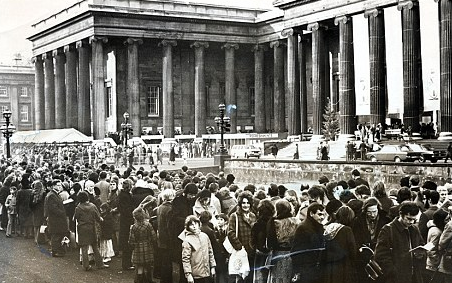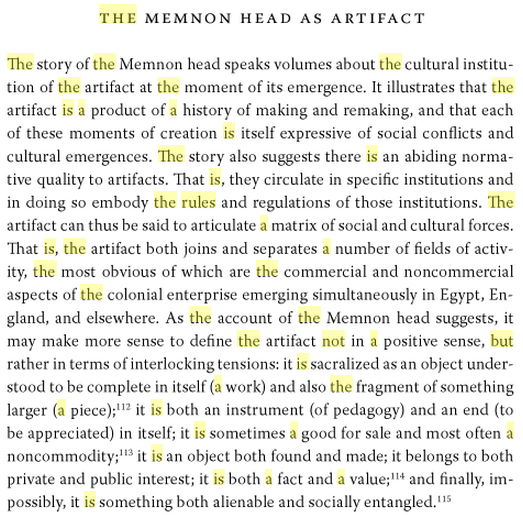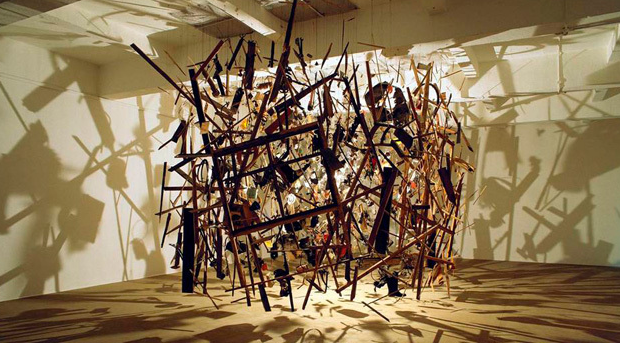CSI of Things
- Friday 20 February, 10am-4.30pm
- Lydia and Manfred Gorvy Lecture Theatre (LT3), Battersea Campus
- The CSI of Things - crime scenes and suspect objects
All objects incorporate traces and signs of their insertion into spatial and historic realms. They condense aspirations and participate in dramas of use and abuse. In this symposium we have chosen to regard objects/things as 'clues'. In fictions there are 'smoking guns', 'MacGuffins' and accessories - components of scenarios and objects of desire and repulsion. 'The Crime Scene' in which our objects are located may not involve a literal crime - it may be any environment in which we seek an explanation for how things come together to create or disturb coherent fictions.
Detectives and forensic scientists (1) share with archaeologists and design historians various processes of induction and deduction to 'explain' or recover an incident or status quo; they try to make objects 'speak'.
Here, we are interested in methods of investigation that reveal an understanding of things and their complex functions. This relates to the story of detection - predicting outcomes from evidence or reconstructing a story from traces at the 'scene of the crime'. We will also explore, through theory and practice, some of the imaginative acts of interrogation and 'animation' that make these objects and scenes 'speak' and perform.
Finally ...in a belief that all objects and spaces can be made to reveal themselves... the 'Antiques Roadshow' format will be used to attempt to detect the significance of some fairly random objects - feel free to bring something...
Speakers include
- Roger Luckhurst, Professor in Modern and Contemporary Literature, with a focus on crime and gothic horror
- Simon Hollington, artist and part of Hollington & Kyprianou; 'Colonel Mustard-Lead Pipe-The Dining Room'
- Tim Edensor, author of Industrial Ruins: Space, Aesthetics and Materiality (2005); 'Wild Speculation: Things in Ruins and Ruined Things'
- Ilona Gaynor, artist, writer and flim-maker; her work takes form as complexly precise plots and schemes, Owner and Director of The Department of No; 'Aesthetics of Precision'
- Brian Dillon, writer, editor of Cabinet magazine and Reader at the RCA on MA Critical Writing in Art & Design; 'CSI of Things does Antiques Road Show'
Convened by Barry Curtis, Naomi House & Monika Parrinder
Details for the day:
- Please be punctual; starts 10am-4.30pm (lunch 1-2pm)
- The Lydia and Manfred Gorvy Lecture Theatre is in the Dyson building, Howie Street entrance and up one flight of stairs: map
Contents
Barry Curtis
readers
- alien phenomenology or what its like to be a thing - bogost
- hyperobjects timonthy morton
- quadruple object - graham harman
- spectralities reader
- Forensics is an interesting way in to the way of thinking about objects - the sheer complexities / intensities of a simple object
- think of all objects as suspicious, needs examination, has a history, detached from its own context that needs to be deconstructed
- rich narrative potentials
- the notion of "property" - what belongs to people
- properties as props, to emphasise narrative elments
- things which audit u
- objects have time, events, may be venerated for being attached to someone famous, resurrected, resignified, their provenance, what context, status, traces, where they touch history
- places ensembles, crime scenes
- obsolescence
- displaced object which shows traces of contact which implicates a person in a crime
- Read: “Morelli, Freud And Sherlock Holmes: Clues And Scientific Method” By Carlo Ginzburg - http://users.clas.ufl.edu/burt/GinzburgMorelliFreudHolmes.pdf
- Mise en scene studies - creating scenario to explain character, the objects testify to or contradict the nature of characters - objects u pick up on when watching a film
- trifles
- assume that all objects are guilty
Roger Luckhurst - Things/ objects / artefacts: the case of the mummys curse
- Roger Luckhurst, Professor in Modern and Contemporary Literature, with a focus on crime and gothic horror
- spent ten years studying two objects with curses on them
Thing Theory
- heidegger things are thought of as "being at hand" - as tools for us
- READ Bill brown thing theory critical quarterly 28, 2001 - "In Byatt's novel, the interruption of the habit of looking through windows as transparencies enables the protagonist to look at a window itself in its opacity. As they circulate through our lives, we look through objects (to see what they disclose about history, society, nature, or culture-above all, what they disclose about us), but we only catch a glimpse of things." We look through objects because there are codes by which our interpretive attention makes them meaningful, because there is a discourse of objectivity that allows us to use them as facts. A thing, in contrast, can hardly function as a window. We begin to confront the thingness of objects when they stop working for us: when the drill breaks, when the car stalls, when the windows get filthy, when their flow within the circuits of production and distribution, consumption and exhibition, has been arrested, however momentarily. The story of objects asserting themselves as things, then, is the story of a changed relation to the human subject and thus the story of how the thing really names less an object than a particular subject-object relation."
- http://www.unc.edu/~jbecks/comps/pdf/brown.pdf
"imagine things, second, as what is excessive in objects, as what exceeds their mere materialization as objects or their mere utilization as objects-their force as a sensuous presence or as a metaphysical presence, the magic by which objects become values, fetishes, idols, and totems."
"If thing theory sounds like an oxymoron, then, it may not be because things reside in some balmy elsewhere beyond theory but because they lie both at hand and somewhere outside the theoretical field, beyond a certain limit, as a recognizable yet illegible remainder or as the entifiable that is unspecifiable. Things lie beyond the grid of intelligibility the way mere things lie outside the grid of museal exhibition, outside the order of objects."
Carnarvon + Tutankhamun
- "The curse of the pharaohs refers to an alleged curse believed by some to be cast upon any person who disturbs the mummy of an Ancient Egyptian person, especially a pharaoh. This curse, which does not differentiate between thieves and archaeologists, allegedly can cause bad luck, illness or death."
- The first of the "mysterious" deaths was that of Lord Carnarvon. He had been bitten by a mosquito, and later slashed the bite accidentally while shaving. It became infected and blood poisoning resulted. He was a frail man to begin with actually, spending winters in egypt, crashing his car and being fragile of health. His 3-legged dog howled (included time differnce) when he died. Two weeks before Carnarvon died, Marie Corelli wrote an imaginative letter that was published in the New York World magazine, in which she quoted an obscure book that confidently asserted that "dire punishment" would follow any intrusion into a sealed tomb. A media frenzy followed, with reports that a curse had been found in the King's tomb, though this was untrue. The superstitious Benito Mussolini, who had once accepted an Egyptian mummy as a gift, ordered its immediate removal from the Palazzo Chigi.
- what no one has seen on the ground for 2000 years - howard carter opened the door, Carnarvon asked him what do you see? carter said "i see things. wonderful things."
- they took years to take the things out.
- elliott colla: "the artefact is not a thing, but embodies the rules and regulations of an institution... the artefact is a prosthesis in the performance of human power relations and a meterial site within a network of forces of humans and nonhumans alike" (quite latourian actor) - from Conflicted Antiquities: Egyptology, Egyptomania, Egyptian Modernity By Elliott Colla
The Unlucky Mummy
- totally stripped of any context in this image
- EA22542 donated by Mrs Warwick Hunt on behalf of her brother 1889
- there is a pre-set text which seems totally wrong at the BM
- http://en.wikipedia.org/wiki/Unlucky_Mummy
- its the inside part of the coffin so it doesn't have names on it, hard to pick out details
- probably a priestess but all the info there is
- great 27th dynasty artefact, thats all people need to know sometimes it is presumed
- roger's research revealed after 10 years that the man who donated it was actually not those guys, but Thomas Douglas Murray (1841-1911) who lived very long for a cursed man, you could even talk to him about it!
- he was very rich, went to luxor, he was sold this
- murray was also responsible for bringing (smuggling) the Pekingese dog to the UK
- occult reputation grows, madame blavatsky and the ghost club
- W T stead - died on the Titanic
- cartonnage mask EA24402 donated by celia ingram (right inside the coffins) - at BM, bought by walter herbert ingram (1855-88) - died at 33 having been a soldier
- ingram was on a missiong to save someone but failed. on the way back. bought this coffin and Mummy of Nesmin
- ripley's believe it or not..... has an false story about watler ingram.... "the mummified hand of an ancient egyptian princess which was found t obe lcutching a gold plaque saying it was cursed. he used the wrong bullet and the elephant he was hunting got annoyed and trampled him.
- THING: the fatal bullet that ingram fired at the elephant. IS A THING. on a mantleplace. they couldn't return the body of ingram so they killed the elephant and sent back to the bullet as a memento to the family (the great grand son)
- 10000 zulus massacre, lundy, a plaque once attached to the thing, that walter ingram used to kill zulus because in the lundy war the brits lost one war against zulu and then decided they would kill all the zulus. ingram probably deserved the curse. but what was the plaque then? is it the thing? the artefact?
- THING > OBJECT > ARTEFACT
- things which cannot get rid of their trails/artefacts/stolen things/smuggled out
Simon Hollington, artist and part of Hollington & Kyprianou; 'Colonel Mustard-Lead Pipe-The Dining Room'
- mcguffins / 38 divinity - thing to get you going then u can throw the element away
- the smoking gun - if the gun doesnt stop smoking then how do u tell when it was fired?
- easier to get a real gun than a toy gun in south london at the time
- john titor - http://en.wikipedia.org/wiki/John_Titor
- operation mincemeat - http://en.wikipedia.org/wiki/Operation_Mincemeat
- READ time and narrative , paul ricoeur
Tim Edensor, wild speculation, things in ruins and ruined things
- Tim Edensor, author of Industrial Ruins: Space, Aesthetics and Materiality (2005); 'Wild Speculation: Things in Ruins and Ruined Things'
- building stone and detective work - to illuminate different dimensions of cities of how the city is composed and recomposed
- the things which are found in ruins - and their qualities
- between 2002-2004 spent time in north britain exploring industrial ruins
- we live in cities and we hae certainencounters with the material world, but what is apparent is how radically decentralised we ar efrom the material world we inhabit
- ruins - brute materiality, textures, smells, hopping over things, negoiations
- body coerced to move in interesting ways, having the ability for once to pick up, smash at will - cos they are useless
- ruins - a different material world contrasts with our urban world
- industrial space, smells, sounds, etc
- defamilisation - aesthetically different to our world. diff aesthetic ordering (compared to our homes and in the city where things are always put back into place and things are arrested from falling apart.
- thng about ruins - not knowing what these things were used for anymore. this kind of speculation and to suppose what these things are is quite interesting.
- by products, off cuts, remnants of industrial process. unfinished things, mingling,
- eclipses the mystery
- contravenes how things ought to be in space - mingling wrongly with other objects
- mystical, new invented narratives
- difficult to tell where one things ends, trees grow, mould, what's mould whats brick, peculiar compounds in which things are inextricably connected and mutating
- discrete no longer....
- pic of iceland british naval base seaweed barnacles, everything devolved into the earth in an uncanny ways, the pier is unrecognisable
- aggregates and compounds - where the single object becomes compound or multiple, or vice versa, fusing together - nails fused togehter giant ball of nails - (commentator: the nails refusing to work individually, like fuck u we arent going to let u use us as nails anymore)
- artwork toril redalen of dust - scraped hte paint off the walls into a pile - READ more?: http://issuu.com/khib/docs/vociferous_void
- when a building starts to fall apart, things spring forth from the walls
- plumbing and wiring announces its presence
- things announce themselves from absense too
- things which were same, now become different. standardisation eclipsed distinctiveness in the past but now.....
- a cupboard labelled KEEP OUT / a brick labeled utopia
- happenstance?
- he says it is difficult to understand.
- the clues suggest all sorts of fantastic possibilities, that we can speculate on, but what do you think is the value of speculation? - to multiply the meanings in a city --> CONNECT THIS WITH COLIN WARD
- to move away from heritage. disordered objects with multiple interpretations of their histories. stories on a small scale.
- TLPS: SMALL STONES IN A CORNER CONCRETE FLOOR. discouraging from walking? small stones....
- building stone
- cornelia parker's exploded shed
- the shed is it exploded - or is it brought together? things are collected into a shed..... as things come together, these things come from different places and have diffferent provenances
- so when we think of stone and its origins..
- eg of various stones. such as portland stone. or sandstone. a geologist might see a different thing. stone brought from a quarry. that millenia before used to be a desert. so you see dips in a stone. so very dramatic turn of stones.
- image of church with different coloured stones. there are sandstone from runcorn, white stone from staffordshire, at the top stone from lake district, the church's stones come from all over. and the repaired stones also come from different places. but the original stones of this church in manchester come from Collyhurst quarry manchester
- buildings are all material composites from elsewhere
- biofilm is eating away the sandstone... it starts to pull apart the stone
- material agencies - who attacks the stone. eg a door way with a metal staple behind it which was fine for 200 years then water percolated and it began to erode.... a replacement would need t obe found soon
- multiple stones, multiple stories - any one specific of speciality cannot do. you need many to tell the story. he needed to learn this from biologist, architect, geologist, multiple narrative, the object holds the centre and is the focus for all the narratives to swirl around. and there we also have innumerable gaps, which cannot be filled with facts.
- Barry: patricia cornwell csi novels - are about time, entomology different fields...
- commentator: daphne du maurier - rebecca's things. they have a different life of their own once abandoned.
- commentator: crime scenes and museum - dont touch. usually. but then... outside of that...? what does it mean, people not daring to touch?
- barry: lost objects - we ask does it belong to someone? we wanna make a narrative already
- simon: people say something about how if there is a picture in it then its likelier to be returned
See also
Notes
- an idea for a lecture when you speak about things and have a taster reel of images related to teh story



